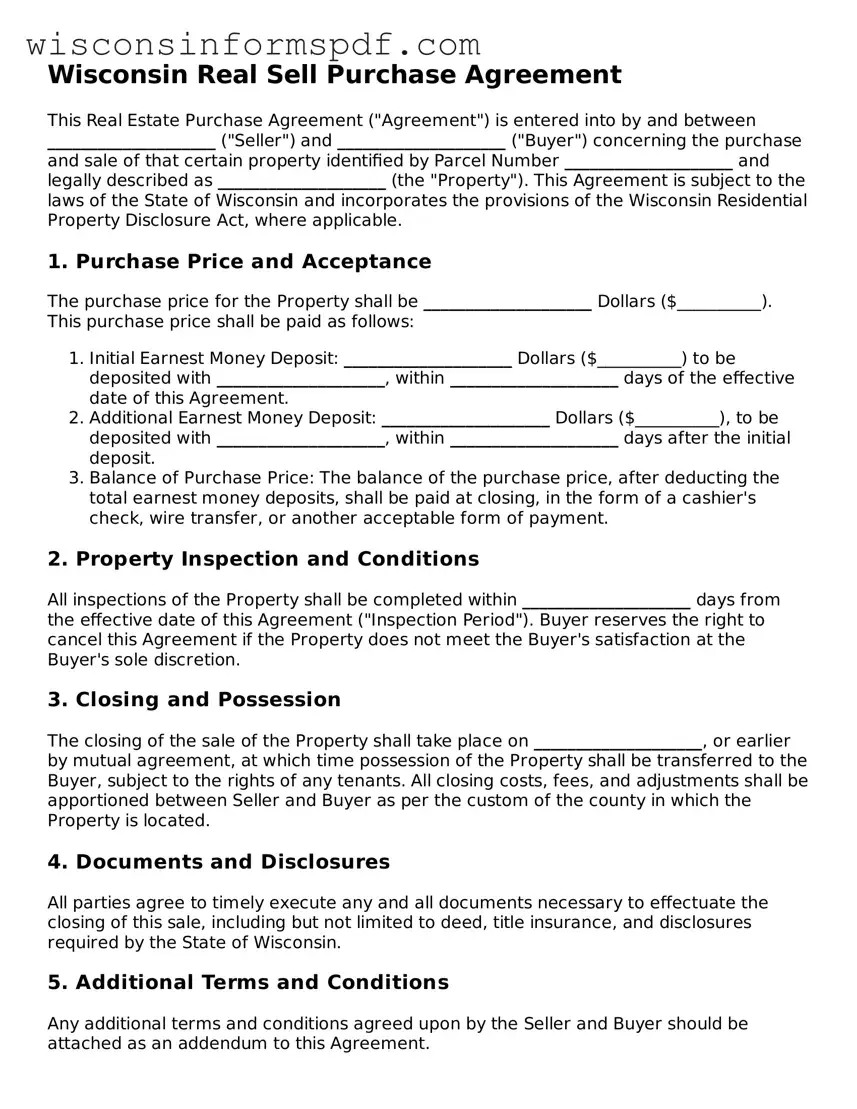What is a Wisconsin Real Estate Purchase Agreement?
A Wisconsin Real Estate Purchase Agreement is a legal document completed by the buyer and seller of real estate. This document outlines the terms and conditions of the purchase and sale of property in Wisconsin, including the sale price, property description, and closing details. It's a binding contract that both parties must adhere to once signed.
Why is a Real Estate Purchase Agreement important in Wisconsin?
In Wisconsin, a Real Estate Purchase Agreement serves as the legal proof of the terms agreed upon between the buyer and seller. It is important because it legally binds both parties to their agreed responsibilities, provides a clear timeline for the sale process, and outlines the transaction's specifics, reducing the risk of misunderstandings. Moreover, it is essential for the closing process and required by lenders for buyers obtaining financing.
Who needs to sign the Wisconsin Real Estate Purchase Agreement?
The Wisconsin Real Estate Purchase Agreement must be signed by all parties involved in the transaction. This includes all listed buyers and sellers. If the property is owned or being purchased by more than one person or entity, each must sign the agreement to ensure it is legally binding.
How can I obtain a Wisconsin Real Estate Purchase Agreement form?
The Wisconsin Real Estate Purchase Agreement form can be obtained from a licensed real estate agent, a real estate attorney, or through online legal document services. Ensure the form complies with Wisconsin state law and is tailored to the specific needs of your transaction.
Does the Real Estate Purchase Agreement need to be notarized in Wisconsin?
While the Real Estate Purchase Agreement itself does not typically need to be notarized in Wisconsin, certain accompanying documents may require notarization. For example, the deed transferring ownership must be notarized to be recorded. It is advisable to consult with a real estate attorney to ensure all necessary documents are properly executed.
What happens if a party backs out of the Wisconsin Real Estate Purchase Agreement?
If a party backs out of a Wisconsin Real Estate Purchase Agreement, the consequences depend on the terms outlined in the agreement itself. Often, there are contingencies that allow a party to withdraw without penalty under specific circumstances. However, if backing out violates the agreement terms, the impacted party may seek enforcement of the agreement or financial compensation for losses incurred. Legal advice should be sought in such situations.
Can amendments be made to the Real Estate Purchase Agreement after it has been signed?
Yes, amendments can be made to the Wisconsin Real Estate Purchase Agreement after it has been signed, but any changes must be agreed upon by all parties involved. Amendments should be made in writing and signed by both the buyer and seller to be legally binding.
Are there any mandatory disclosures that must be included in the Wisconsin Real Estate Purchase Agreement?
Yes, Wisconsin law requires certain disclosures to be made as part of the Real Estate Purchase Agreement. These include, but are not limited to, the existence of lead-based paint (for properties built before 1978), the condition of the property, and any known material defects. A complete list of required disclosures can be obtained from a Wisconsin licensed real estate professional or attorney.
What happens at the closing of a real estate transaction in Wisconsin?
At the closing of a real estate transaction in Wisconsin, all parties involved come together to finalize the sale. During this meeting, documents are signed, including the deed transferring ownership, the buyer secures financing and pays the seller, and the seller provides the keys to the property. The exact process may vary, but it typically involves a title or escrow company and possibly real estate attorneys, ensuring that all legal and financial obligations are met and the property's ownership is officially transferred.
